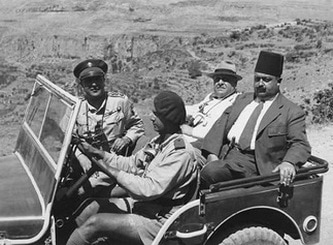 Bechara Al-Khoury
Bechara Al-Khoury
1943: The first government of independent Lebanon is formed, with Bechara al-Khoury as the first elected president. In response to the government’s demand to make Lebanon fully independent, the French arrest a number of prominent ministers and members of parliament, and imprison them in a Citadel in Rachaya el-Wadi. After British pressure and huge street protests, they are released two weeks later on 22 November, the day now celebrated as Lebanese Independence Day. The National Pact ends up as a compromise between Christian and Muslim communities, the former forsaking the need for French governance, while the latter looking to join Lebanon with Syria.
The Pact becomes an unwritten agreement giving an Arab image to Lebanon by including it as a member in the Arab League, while maintaining its independence as a country, separate from Syria. According to the National Pact, the governmental and administrative power is divided amongst the three main religious communities - Christians, Shi’ites and Sunnis - in line with the population size of each group. As a result, the president should be a Maronite, the prime minister should be a Sunni, and the speaker of the parliament should be a Shi’ite. In 1943, the French Mandate is excluded from the Lebanese constitution and Arabic becomes the official language.
1945 - 1946: Lebanon joins the United Nations and the Arab League of States. It is not until 1946 that the last French troops leave Lebanon.
1948: The first Arab-Israeli war breaks out and hundreds of thousands of Palestinians - mainly Sunnis - escape to Lebanon.
1952 - 1958: In 1952, the pro-Western President Camille Chamoun is elected, making even more tenuous the position of non-Christian Lebanese; the latter being represented by Kamal Jumblatt’s Social National Front (SNF), along with other parties. Opposition grows, especially after Chamoun openly supports the Western invasion of Egypt in 1956, and the Pan-Arab nationalism of Egyptian President Gamal Abdel Nasser becomes increasingly prominent.
1958: The conflict between Chamoun and the pan-Arab opposition intensifies when the former seeks another term as president and Syria merges with Egypt and street battles start to take place between Christians and Muslims. After the interference of the US, with Chamoun invoking the terms of the Eisenhower Doctrine, Fouad Shehab - commander of the Lebanese Armed Forces - succeeds Chamoun as president.
1964: Charles Helou is elected president.
1967: Cross-border attacks between Israel and Palestinian refugees start. The Six Day War increases the number of Palestinian refugees in Lebanon.
1969: Following the Cairo Agreement, the Lebanese government is forced to let the PLO (Palestine Liberation Organization) use its territory as part of the resistance against Israel, yet under strict conditions. The PLO, through its arms strength, soon becomes a local political actor within Lebanese politics. It allies itself with local politicians such as Kamal Jumblatt, in opposition to Maronite/Christian political parties (e.g. the Phalangists) who seek to limit the influence of the PLO. Fights between Lebanese army troops and the Palestinians start in the south of Lebanon.
1970: Suleiman Franjieh is elected president in Lebanon. Street fights between the Phalangist militia and the Palestinians erupt on the streets of Beirut. In the same year, the PLO is expelled from Jordan and regroups in Lebanon.
1973: The Yom Kippur War takes place by Egypt, Syria and Jordan against Israel. The PLO opens its headquarters in West Beirut and cross-border attacks between the PLO and Israel are launched. At the same time, clashes between Palestinians and Lebanese army troops continue and slowly Beirut becomes more and more divided over the presence of the PLO in Lebanon, with civilians sympathetic to the PLO moving to West Beirut, while opponents settle in East Beirut.

